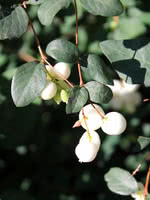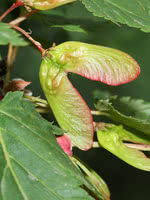Mon-Fri 9am - 5pm Mountain time
Western Snowberry vs Douglas Maple
Symphoricarpos occidentalis
Acer glabrum
NOT AVAILABLE THIS SEASON - MIGHT RETURN
CUSTOM GROW
Like the Common Snowberry, the Western Snowberry is a small shrub with pink flowers useful for feeding livestock and preventing erosion. Unlike the common species, however, the Western Snowberry is much more suited to wet conditions, capable of persevering through poor soil drainage and occasional flooding.
After the Snowberry's flowers have bloomed, it produces berries which often last on the plant through winter. These berries are toxic to humans, but livestock and local wildlife love them! Those hoping to attract wildlife to their property can plant Snowberry and expect to see animals foraging on it much later in the year than other plants.
Douglas Maple is a fast growing, long lived, ornamental tree. It can take on a shrubby or multi-stemmed form with densely packed leaves, making it an excellent tree for privacy screens and hedges.
In the fall, the leaves make a brilliant change to red, orange, or yellow depending on the tree and its sun exposure. Douglas Maple's compact size makes it ideal for planting in urban yards and under power lines.
Western Snowberry Quick Facts
Douglas Maple Quick Facts
Toxicity: berries are toxic to humans

